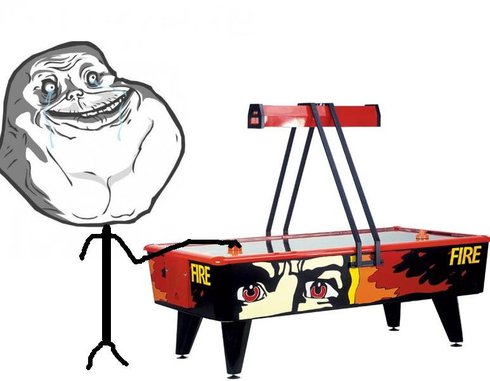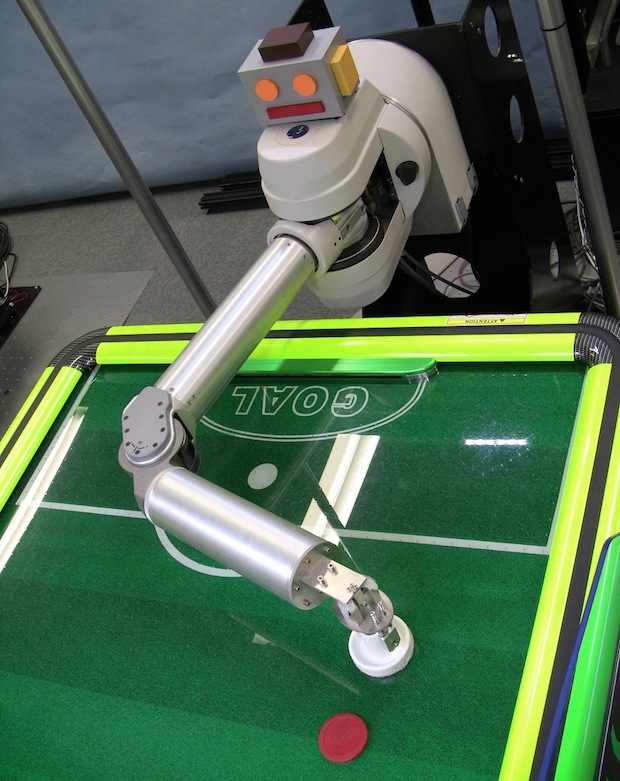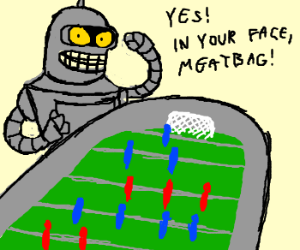Overview of robots for board games
Board games love everything. But sometimes the opponent may be unavailable. And then what to do, all alone? Robots will come to the rescue! In the post we consider robots created for playing table tennis, air hockey, billiards and table football. In some cases, robots are made specifically for the game, but in others they are universal help robots or industrial-purpose robots.

Table tennis is over a hundred years old. Only this game gained popularity at the end of the century before last, and the name Ping-Pong appeared presumably in 1901. Of course, robotics was simply obliged to reach this sport.
')
The recent rivalry between Timm Bol and the tennis robot from Kuka did not become the first in the confrontation of people and machines. Let's start with the simplest devices. In the video below - simulators that can only throw balls, but do not have a hand to beat. They will help you learn how to repel attacks.
Such a device, if desired, can be assembled in your own garage.
In China, at Zhejiang University in Guangzhou, in 2011, a more advanced robot was developed. In the video, two such robots play against each other, then one - against a human. At that time, the best result in the game of robots against each other is 176 shots, more than two minutes of play. And with a man - 145 hits. Unfortunately, the speed of these robots is clearly not enough for a serious game with a man.
A year ago, in May 2013, a video with this robot box for playing table tennis was published online. In the video roboruku teach primitive movements of the game. In order to further beat the balls, the robot combines the known blows. The more he trains - the better he plays. Just like a man.
Well, how not to remember the disappointment of this month - the Kuka robot. In February, a post appeared that a fight between Timo Boll, fifteen-time European champion, six-time world championship winner, silver and bronze champion of the 2008 and 2012 Olympic Games against KR 6 R900 SIXX (KR AGILUS) made by German company Kuka, will soon take place.
We all together, including me, waited for the video from the real duel, wanted to see a bloody battle ... And we received a complete pathos-mounted video with a huge amount of slow-motion.
Much more impressive is the UHTTR-1 robot from Germany, on which its creator, Ulf Hoffman, worked for two years. Due to the presence of the chassis, the ease of materials - aluminum is used, as well as high-quality servomotors, the rokhoruka is very mobile, and thanks to good software - it is able to learn the game. She still does not know how to serve, but Hoffman continues to work on this.
Air hockey is a relatively young sport. It appeared only in the 1960s, absolutely by accident: three engineers built a table for testing the air circulation that is needed for other projects, and in their free time they played around this table. Later they decided to show the world their creation.
The robot plays for the white team. I could not find any details about this robot, unfortunately - the link to the video does not work anymore.
In June 2013, Japanese developers at Nibiki’s Chiba Laboratory introduced this pretty air hockey robot.

In February, this video appeared. The robot on it is assembled from an air hockey table, 3D printer parts, a PlayStation Eye camera and an Arduino Mega microcontroller. The robot is able to predict the movement of the puck, and he does not need to give in. The difficulty level can be customized if desired.
Homeland billiards with equal chances could be Asia, India or China. The first known billiard table was made for Louis XI in 1469, and he got to Russia thanks to Peter I. The essence of the game is to cue the ball into the pocket, and the other rules depend on the specific type of game.
For a robot playing billiards, it is important to correctly calculate the direction and force of impact. In 2009, Queens University developed Deep Green, a billiards robot. The design looks daunting, and the impact efficiency is off the scale.
In 2010, Willow Garage trained its PR2, the Personal Robot 2, in playing billiards. The PR2 is a humanoid robot equipped with two hands with seven degrees of freedom and a carrying capacity of 1.8 kilograms, sensors, including a 5 megapixel camera and a laser range finder. The robot is based on two computers with 8-core servers, each of which contains 24 gigabytes of RAM. Works PR2 on 16 batteries from laptops.

In 2011, PR2 had a worthy rival for playing at the pool table. Thomas Nierhoff of the Technical University of Munich presented a man-sized robot, also equipped with 7-degree arms. Manipulators are able to hold a cue in their hands as well as a person does, but more effectively thanks to a camera mounted above the table.
On the 2012 video, a demonstration of the ABB IRB120 robot playing snooker. Not only that he drove the ball into the hole, he also knows how to rejoice at his victories. This industrial robot weighs 25 kilograms and has a carrying capacity of 3 kg and a working area of up to 58 centimeters.

It is not possible to determine the creator of table football, since at the beginning of the last century many patents on this topic were submitted. Perhaps it was Citroën employee Lucien Rozangartan, or Spaniard Alejandro Finisterre, editor. The only thing you can be sure of is that the prototype of the modern table appeared before the beginning of the 20s of the last century.
In this case, the robot should, just like a human, control the levers by moving them back and forth and around the axis. In 2002, a KiRo robot was introduced to play table football at RoboCup. 50 times a second, KiRo receives information from the sensors and decides on further actions, after which it sends commands to the engine controllers.

Later this project became really massive in the form of a game table StarKick.

This video presents a robot for playing table football. In fact, at the time of the publication of the video on Youtube (August 2013), only one roboruk was ready, controlling only one lever. But her ability to send the ball at a speed of 6 meters per second to the right place allowed her to win a man in this unequal battle. For the work of the hand, the simultaneous work of two computers is necessary - one makes the arm move, and the other supplies it with information. The camera for the second computer is installed under the transparent table. Developers are planning in the future to do with one computer.
It is interesting:
Alternative GDC Arcade: Home-Made Freak Controllers Gallery
The history of game consoles in advertising. Part 1: From Magnavox Odyssey to Super Nintendo
The history of game consoles in advertising. Part 2

Table tennis
Table tennis is over a hundred years old. Only this game gained popularity at the end of the century before last, and the name Ping-Pong appeared presumably in 1901. Of course, robotics was simply obliged to reach this sport.
')
The recent rivalry between Timm Bol and the tennis robot from Kuka did not become the first in the confrontation of people and machines. Let's start with the simplest devices. In the video below - simulators that can only throw balls, but do not have a hand to beat. They will help you learn how to repel attacks.
Such a device, if desired, can be assembled in your own garage.
In China, at Zhejiang University in Guangzhou, in 2011, a more advanced robot was developed. In the video, two such robots play against each other, then one - against a human. At that time, the best result in the game of robots against each other is 176 shots, more than two minutes of play. And with a man - 145 hits. Unfortunately, the speed of these robots is clearly not enough for a serious game with a man.
A year ago, in May 2013, a video with this robot box for playing table tennis was published online. In the video roboruku teach primitive movements of the game. In order to further beat the balls, the robot combines the known blows. The more he trains - the better he plays. Just like a man.
Well, how not to remember the disappointment of this month - the Kuka robot. In February, a post appeared that a fight between Timo Boll, fifteen-time European champion, six-time world championship winner, silver and bronze champion of the 2008 and 2012 Olympic Games against KR 6 R900 SIXX (KR AGILUS) made by German company Kuka, will soon take place.
We all together, including me, waited for the video from the real duel, wanted to see a bloody battle ... And we received a complete pathos-mounted video with a huge amount of slow-motion.
Much more impressive is the UHTTR-1 robot from Germany, on which its creator, Ulf Hoffman, worked for two years. Due to the presence of the chassis, the ease of materials - aluminum is used, as well as high-quality servomotors, the rokhoruka is very mobile, and thanks to good software - it is able to learn the game. She still does not know how to serve, but Hoffman continues to work on this.
Air hockey
Air hockey is a relatively young sport. It appeared only in the 1960s, absolutely by accident: three engineers built a table for testing the air circulation that is needed for other projects, and in their free time they played around this table. Later they decided to show the world their creation.
The robot plays for the white team. I could not find any details about this robot, unfortunately - the link to the video does not work anymore.
In June 2013, Japanese developers at Nibiki’s Chiba Laboratory introduced this pretty air hockey robot.

In February, this video appeared. The robot on it is assembled from an air hockey table, 3D printer parts, a PlayStation Eye camera and an Arduino Mega microcontroller. The robot is able to predict the movement of the puck, and he does not need to give in. The difficulty level can be customized if desired.
Billiards
Homeland billiards with equal chances could be Asia, India or China. The first known billiard table was made for Louis XI in 1469, and he got to Russia thanks to Peter I. The essence of the game is to cue the ball into the pocket, and the other rules depend on the specific type of game.
For a robot playing billiards, it is important to correctly calculate the direction and force of impact. In 2009, Queens University developed Deep Green, a billiards robot. The design looks daunting, and the impact efficiency is off the scale.
In 2010, Willow Garage trained its PR2, the Personal Robot 2, in playing billiards. The PR2 is a humanoid robot equipped with two hands with seven degrees of freedom and a carrying capacity of 1.8 kilograms, sensors, including a 5 megapixel camera and a laser range finder. The robot is based on two computers with 8-core servers, each of which contains 24 gigabytes of RAM. Works PR2 on 16 batteries from laptops.

In 2011, PR2 had a worthy rival for playing at the pool table. Thomas Nierhoff of the Technical University of Munich presented a man-sized robot, also equipped with 7-degree arms. Manipulators are able to hold a cue in their hands as well as a person does, but more effectively thanks to a camera mounted above the table.
On the 2012 video, a demonstration of the ABB IRB120 robot playing snooker. Not only that he drove the ball into the hole, he also knows how to rejoice at his victories. This industrial robot weighs 25 kilograms and has a carrying capacity of 3 kg and a working area of up to 58 centimeters.
Table soccer

It is not possible to determine the creator of table football, since at the beginning of the last century many patents on this topic were submitted. Perhaps it was Citroën employee Lucien Rozangartan, or Spaniard Alejandro Finisterre, editor. The only thing you can be sure of is that the prototype of the modern table appeared before the beginning of the 20s of the last century.
In this case, the robot should, just like a human, control the levers by moving them back and forth and around the axis. In 2002, a KiRo robot was introduced to play table football at RoboCup. 50 times a second, KiRo receives information from the sensors and decides on further actions, after which it sends commands to the engine controllers.

Later this project became really massive in the form of a game table StarKick.

This video presents a robot for playing table football. In fact, at the time of the publication of the video on Youtube (August 2013), only one roboruk was ready, controlling only one lever. But her ability to send the ball at a speed of 6 meters per second to the right place allowed her to win a man in this unequal battle. For the work of the hand, the simultaneous work of two computers is necessary - one makes the arm move, and the other supplies it with information. The camera for the second computer is installed under the transparent table. Developers are planning in the future to do with one computer.
It is interesting:
Alternative GDC Arcade: Home-Made Freak Controllers Gallery
The history of game consoles in advertising. Part 1: From Magnavox Odyssey to Super Nintendo
The history of game consoles in advertising. Part 2
Source: https://habr.com/ru/post/215961/
All Articles